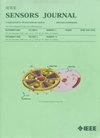Two-Dimensional Topological Structures Boost the Construction of Nonequilibrium Array for Optical Pressure Sensing
IF 4.3
2区 综合性期刊
Q1 ENGINEERING, ELECTRICAL & ELECTRONIC
引用次数: 0
Abstract
Pressure-induced optical materials show great potential in optical devices, pressure sensing, and information anticounterfeiting. However, pressure-induced room temperature phosphorescent (RTP) molecules in a thermodynamic steady state are insensitive to external stimuli, limiting their practical application. Here, layered double hydroxide (LDH) with a 2-D topological structures can bring carbon dots (CDs) into a thermodynamic nonequilibrium state, which is a prerequisite for the enhancement in pressure sensitivity. Furthermore, considering the inherent rigidity of LDH contradicts the pressure sensitivity, the dual buffering layers are introduced, where the borate ions and polymer polyvinyl alcohol (PVA) as internal and external buffer layers, respectively. The dual buffering layers can help interlayer molecules to achieve highly anisotropic arrangement and induce the initial formation of thermodynamic nonequilibrium arrays. Thus, the CDs@BO3-LDH-PVA film can change the RTP intensity significantly under the extremely low pressure of 12 MPa. This strategy links the nonequilibrium state with the buffer layer, which provides a new idea for the design of pressure-induced optical sensing material.求助全文
约1分钟内获得全文
求助全文
来源期刊

IEEE Sensors Journal
工程技术-工程:电子与电气
CiteScore
7.70
自引率
14.00%
发文量
2058
审稿时长
5.2 months
期刊介绍:
The fields of interest of the IEEE Sensors Journal are the theory, design , fabrication, manufacturing and applications of devices for sensing and transducing physical, chemical and biological phenomena, with emphasis on the electronics and physics aspect of sensors and integrated sensors-actuators. IEEE Sensors Journal deals with the following:
-Sensor Phenomenology, Modelling, and Evaluation
-Sensor Materials, Processing, and Fabrication
-Chemical and Gas Sensors
-Microfluidics and Biosensors
-Optical Sensors
-Physical Sensors: Temperature, Mechanical, Magnetic, and others
-Acoustic and Ultrasonic Sensors
-Sensor Packaging
-Sensor Networks
-Sensor Applications
-Sensor Systems: Signals, Processing, and Interfaces
-Actuators and Sensor Power Systems
-Sensor Signal Processing for high precision and stability (amplification, filtering, linearization, modulation/demodulation) and under harsh conditions (EMC, radiation, humidity, temperature); energy consumption/harvesting
-Sensor Data Processing (soft computing with sensor data, e.g., pattern recognition, machine learning, evolutionary computation; sensor data fusion, processing of wave e.g., electromagnetic and acoustic; and non-wave, e.g., chemical, gravity, particle, thermal, radiative and non-radiative sensor data, detection, estimation and classification based on sensor data)
-Sensors in Industrial Practice
 求助内容:
求助内容: 应助结果提醒方式:
应助结果提醒方式:


